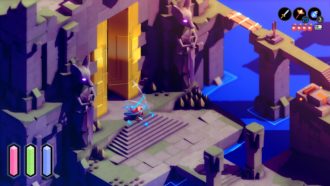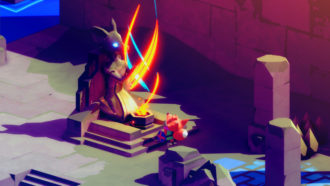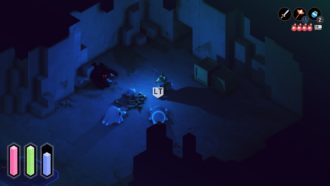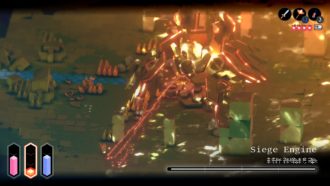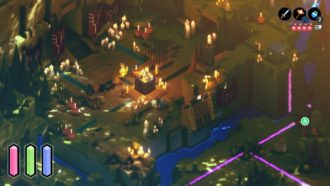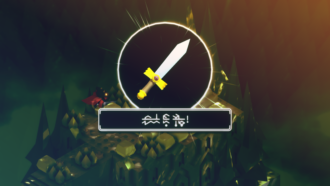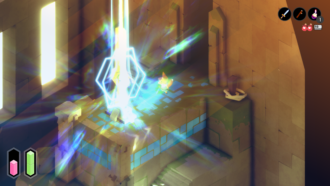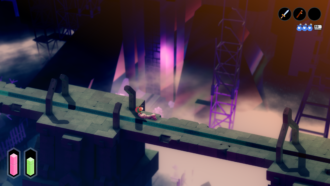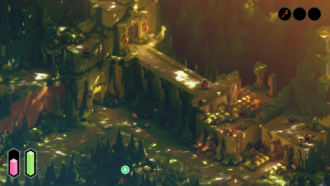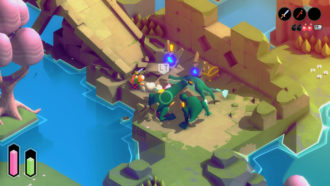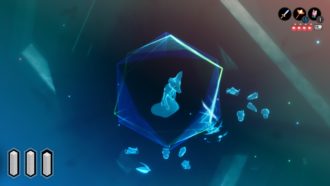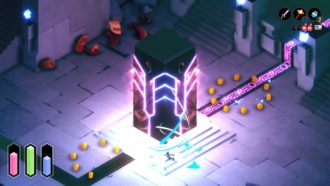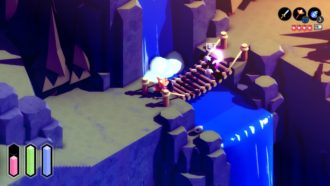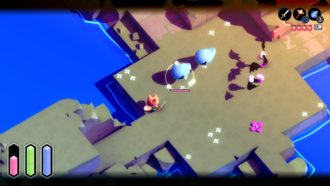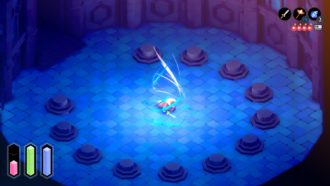Platforms:
Xbox One, PC, Xbox Series X|S
Released:
March 16, 2022
Publisher:
Finji
Developer:
Andrew Shouldice
Announced many years ago as Secret Legend, TUNIC follows a cute little fox who explores a land full of secrets, ancient powers, and aggressive monsters. The isometric adventure game looks and plays similar to the classic The Legend of Zelda experience and last year’s Death’s Door. The solo developer behind the game, Andrew Shouldice, has used that inspiration to creatively design this Metroidvania so intuitively it may be a new fan favourite.
Omnipotent power in a hidden land
TUNIC begins with our modest fox stranded on a beach. With no direction, no hints, and no weapons, players must slowly unravel the mystery behind this world and the hero’s connection to a long history. Interest and discovery are vital in learning the story and exploring this land where colossal beasts and strange puzzles lead to cracking open the tale.
Along the journey, glowing pages are collected to piece together an instruction manual. Coded within an unknown language, at first glance the information is gibberish. To the keen eye, each page provides essential details on what to do, how to get there, what you might need to use, what areas and bosses are upcoming, and hints and tricks along the way. Not even the items, weapons, and game mechanics themselves are distinctly explained in the traditional sense. Secrets loom between these pages and the world that reveal themselves later on.
“Knowledge is power, and the only way to learn more is your own curiosity and attention.”
The obvious homage to classic video game manuals acts as your bible, beaming with nostalgia and passion for the genre, and will have people debating on meanings for a while. It’s a brilliant way to expand the puzzle elements of this game to more than just the gameplay. Knowledge is power, and the only way to learn more is your own curiosity and attention.
As you can probably tell already, TUNIC is much deeper than it looks on the surface. It’s not easy to describe the narrative that complements the puzzles and exploration without spoiling the fun. If you enjoy the story-telling of Dark Souls or Elden Ring, where the player chooses to learn about the lore, this will be an amazing 10 to 15 hour game for you.
A sword and a lot of will
As an isometric puzzle adventure, there are a lot of mechanics and tools our fledgling fox finds along the way. Beginning with the basics, there are three meters for health, stamina, and magic powers. Attacking enemies with a sword, dodging out of the way of lasers or blocking an incoming strike, and casting magic out of a wand depletes power. Managing these resources for challenging battles is essential, especially when entering unknown and ominous areas.
Upon death, you’ll leave a ghost and lose a small portion of currency. The fox respawns at one of the many shrines placed around the world and will need to return to the point of death to retrieve the coins. Currency can be used at hidden shops, helmed by a terrifying creature, to purchase items and consumables. It’s very Souls-like without the major punishment of losing everything upon death, which is appropriate as the game wants you to focus less on the difficulty and more on discovery.
Quickly, more and more equipment open up other strategies to the unassuming hero. You’ll be able to collect and purchase a range of throwables that are crucial for specific encounters, like dynamite and ice bombs to help defeat stronger shielded foes. Consumables can also refill power meters and even give a unique damage boost. Don’t think you should horde these all for a big fight; the game encourages using items by providing bonus drops and replenishments the more you use them. It’s a practical arsenal to play around with, which grows and surprises as the quest continues.
“…a practical arsenal to play around with, which grows and surprises as the quest continues.”
My only issue with TUNIC is unfortunately the combat. While there are plenty of approaches to what items to use and when, the typical attacking and defending is very straightforward. Often, swinging relentlessly at enemies is a faster and more convenient option than using your shield and timing attacks correctly. Some obstacles require more thinking, but enemies like the Rudelings are just fodder and aren’t too bright.
The game also uses the left trigger to lock-on to an enemy. While it helps with aiming, it can also lead to clunky action and sometimes frustration. Targeting doesn’t always select the right enemy, and in situations with more than three creatures trying to attack at once, switching between your targets can be needlessly tricky.
Despite some problems, the combat doesn’t demerit the excellent boss fights. Some of these monstrous beings are incredibly daunting on the first encounter. Yet, there is always a tool or tactic that will help. These may be discovered through exploration, within the instruction manual, or just from trial and error. For example, the game will suggest levelling up certain powers before defeating the Garden Knight. While they aren’t really that tough, defeating bosses with a clever approach creates a great level of pride.
Explore and discover
TUNIC rewards players who take their time and explore every nook and cranny. The world is split into different zones with a unique feel, music, and enemies. Each has a variety of puzzles and key items to collect, hidden between secret paths and smart level design.
You’ll return to the same zones often. Unlocking tools mean new paths and ways to get around quickly will now be open to you, so constantly revisit the beginning areas of the Overworld, East Forest, and West Garden. Getting lost is normal and should be cherished; there is no handholding and where you head next is up to your own volition. It’s the player’s responsibility to remember the zones, refer to the instruction manual for tips, recognise places to return to, and progress. This might be a barrier for people with little patience or not much time, but an absolute strength for others.
“…the camera is a crafty magician, hiding all the secrets in plain sight.”
Within all the exploration is very clever level design. As paths circle back to familiar areas, you’ll notice inventively placed ladders and staircases that are simply shrouded by the camera angle. Several covert paths left me dumbfounded, left open to use at any time, but without the knowledge I was oblivious. Sadly, fixing the camera does cause minor problems with getting stuck in corners behind the environment, especially when a few enemies are attacking. Regardless, the camera is a crafty magician, hiding all the secrets in plain sight.
That ignorance flows into using items and places of interest, too. Specific abilities and collectables can be used immediately for a huge boost, but how and when isn’t revealed until more manual pages are gathered. You may even be smart enough to decipher the coded language and even better understand the world and how it operates. TUNIC is a game for second playthroughs and I expect some incredible speedrunning records shortly.
Cute and bright with a lot of might
TUNIC has a beautifully illustrated style reminiscent of old-school action adventures. The world, colourful and soft, glows with a charm that only grows with each area you find. Explore a hostile and intricately-connected world of shady forests, sprawling ruins, and labyrinthine catacombs that all stand out from each other with a distinct feel and mood. It also features a range of accessibility options and controls suitable for players who need them.
The character design and animation are also fantastic. Our fox friend trots across the world, dodging and slashing with an apt bounce. The enemies are the same, fitting within the universe regardless of how brutal they are. My favourite is the Chompignoms, wonky two-legged crocodiles who are always hungry and very overwhelming to the unprepared adventurer.
The instruction manual is a creative feat. It may easily be the most impressive and sought after if it was an actual gamebook. So much of the game’s masterful art design and drawings are on show and with purpose. Maps of areas, scribbles of characters, tooltip boxes, and even the full-page spreads are just magnificent to gawk at and provide hints on making progress. All with a specially drawn style complementing the tone of the game.
Audio isn’t left out of this, either. Power Up Audio is working on the sound design and Lifeformed (Terence Lee and Janice Kwan) composing the ethereal soundtrack. The detail and range are phenomenal—pages flipping in the instruction manual, the clanging of a sword against metal forks and shields, and the electrical charges of obelisks are all unique and superb. The backing music is memorable, light, and adventurous, to appropriately accompany the game. Both work in tandem to deliver an outstanding sound experience.
9
Amazing
Positive:
- Full of secrets and discovery
- Clever level design
- Memorable nostalgic style and tone
- Instruction manual is a terrific idea
- Gameplay that keeps evolving the more you know
Negative:
- Some concerns with melee combat
- Minor camera angle issues
TUNIC is a dense journey filled with hidden paths and puzzles that provide a remarkable sense of accomplishment. Using an in-game instruction manual is a brilliant idea that makes learning and gradually revealing how the world works more enjoyable. While the combat isn’t flawless, the rest of the exploration is. This is a game for fans of classic action adventures, cute little foxes, discovery, and secrets. However, the real secret is how wonderful TUNIC is.
